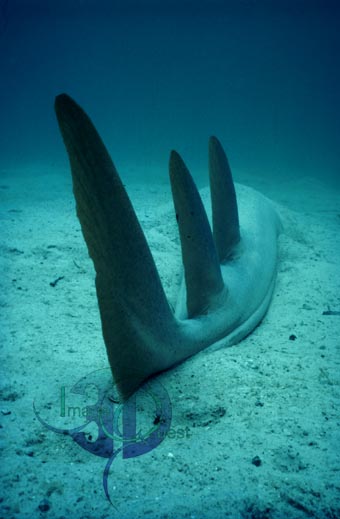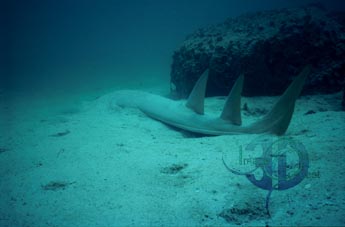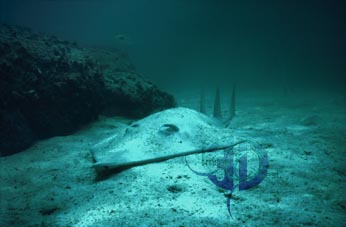|
Fish Tales
 Regular as clockwork, every evening, 6 O’clock, come rain
or shine, a rubber-duck would skim out through the lagoon channel, close
by Palfrey, round lighthouse head and into the Deep Water Channel. Come 7 O’clock, with luck, the same craft
would return, plus two containers of plankton and one bucket of clean
oceanic water. The location was Lizard Island Research Station. The rubber-duck was the aussie name for our
inflatable and the skipper of this insignificant craft and its oft-repeated
journey was me. Over the years
I have probably completed the best part of five hundred such trips. One in twenty would be over calm water and
of those five percent, maybe ten percent would find me swimming ashore
in the final glow of daylight, over rippled sand and between the eight
or nine moorings out in front of the station, watching as I swam, and
finally waded, for blue spotted sting rays or their bigger whip-tailed
cousins. Once in a while I’d surprise three or
four strangely shaped characters – half ray and half shark. These were shovel-nosed rays, Rhinobatos
batillum. They varied in
size from half a metre to a metre in length.
They were such odd-ball characters, I always hoped to come upon
them, by day, in good visibility and time enough to watch them going
about their business. In February 1983 I was granted this privilege,
but in a way that I shall never forget. Tucked away in one corner of the lagoon that fills the space
between South Island, Palfrey Island and Lizard Island is one of the
smallest red mangrove areas I’ve seen.
It covers an area of about half an acre.
Over the years we have found that this shallow, sheltered, slurping
habitat nearly always reveals something of interest if only you are
patient enough. At high water, two metres deep, at low at water,
exposed. Timing is critical.
Visibility is variable, from pea-soup to twenty metres.
Snorkelling is as good as scuba, unless lying flat on the bottom
by the hour is the selected method of observing.
Encounters are as frequent by waiting for it to come to you as
vice versa. Silent and slow
movements are mandatory. The
rewards are worth the cramp and “pins and needles”.
When tides were right we’d spend half days there and when
they were wrong we’d often visit the area en route to and from
other dive sites just to monitor what was going on.
One January day in 1983, we made a morning of it.
My partner and I split to opposite ends of the grove and agreed
to work steadily towards each other.
We both wore tanks. I
had a movie camera and we both had underwater stills cameras.
It was the wet season. The
weather was overcast, and calm – rain was not far away.
We respectively crept around – much of it by hand power
amongst the aerial roots so characteristic of red mangrove. Mangrove seed pods, like fishing floats, were
bobbing around us. An hour passed
and my findings had been few but fun.
A baby barracuda swimming close by a tetragnathid spider’s
web amused me. A cowtail ray or two tucked amongst the roots
gave me a chance to practice some stealth tactics. I watched a twelve inch squillid, mantis lobster
repair its burrow entrance. I
felt something touch my arm. My
partner beckoned me to follow him and not waste time.
We swam in silent tandem back towards the bay where our boat
was moored. As we rounded the
spur of mangrove, my partner indicated particular stealth and then held
his arms wide, indicating large size.
Oh yes – another big sting ray that would disappear into
oblivion before we got anywhere near.
My partner noticed my scepticism and broke surface, removing
his demand valve sufficient to gurgle “shovel-nose ray – huge!” Uh-uh, I thought – all of a metre long.
Into the gloom we returned and my guide then slowed, stopped and pointed. I peered.
Solid gloom. Something
vaguely sticking out of the sand – no, two things – no,……
three, all identical. I crept forward on finger tips. What were these three things and why side by
side? My eyes accustomed to
the low contrast scene. I looked
left and right. Suddenly it
dawned on me. The three things were all part of the same
and all were in line – occupying only the hind quarter of what
I could now see was an enormous flattened body.
My partner was absolutely right.
This beast was huge. I
estimated it to be ten foot long and to weigh well over half a ton. This was a serious fish. The
three vertical ‘sails’ were the tail fin, the adipose fin
and the dorsal fin – all almost identical and each standing three
quarters of a metre off the floor of the lagoon.
The next question was how to do justice to it photographically. I decided, stills first, movie second. The Nikonos around my neck had a new roll of
film in it and a 24 mm lens. To
make this creature look the size it was, I was going to have to get
very close. At this stage I was broadside on. On the basis that being hit by half a ton of
pointed ray was less to my liking than being flicked in the face by
its tail, I decided to try the approach from the rear.
Finger power eased me forward at a snail’s pace. Now my heart was thumping, not because of fright,
just because I so wanted a decent shot. Closer and closer I crept until the caudal fin loomed large in the
viewfinder. I began to click
away, scared that the percussive note would frighten her away. (The sex of the beast was female I believe
since I could see no signs of claspers).
The ray remained motionless.
Click, creep, click, creep.
I could now reach forward and easily touch the caudal fin. This was the shot, with those three sails,
en echelon. I backed away and
began a laborious circumnavigation on a fifteen metre diameter arc to
get ahead of the ray. Now I
had real reason to be apprehensive.
From the front this shovel-nose looked extremely mean and with
those fins at the back end, she sure wouldn’t hang around when
she decided to go. Now I was
six foot from the snout. Click.
Now five feet. Click. Four
feet. Click. My nerve ran out. I eased off, reminding myself I still wanted a movie sequence and
a head on my shoulders!
I sidled back to the boat, exchanged cameras and re-approached
madam, from the side and a little behind. This time I wanted movement, but the roll of
film had only twelve seconds of film to run.
I crept towards the three sails.
A lateral establishing shot first.
Got it. Six or seven
seconds left. Closer. Just before I settled for the shot – the intention movement
of imminent departure – the operculum rose an inch or so. Sure enough she was off and away in her own
‘smoke’ screen of sand. I
shot it, but I would have so liked to be closer and to have had more
film. None the less, a memorable encounter and like
all fishy tales my partner’s arms held wide had been out by a factor
of two, but downwards, not upwards on this occasion! |
||||||||||||
|
|
||||||||||||



